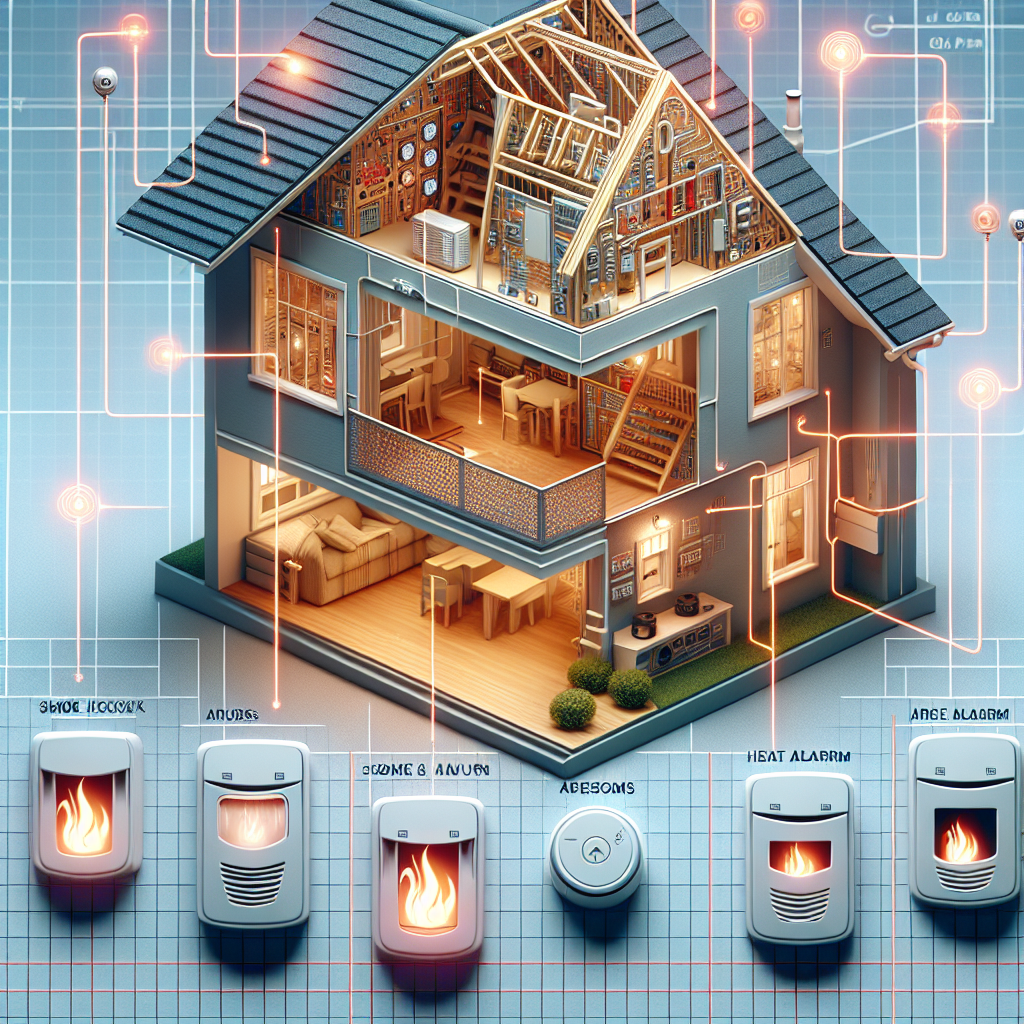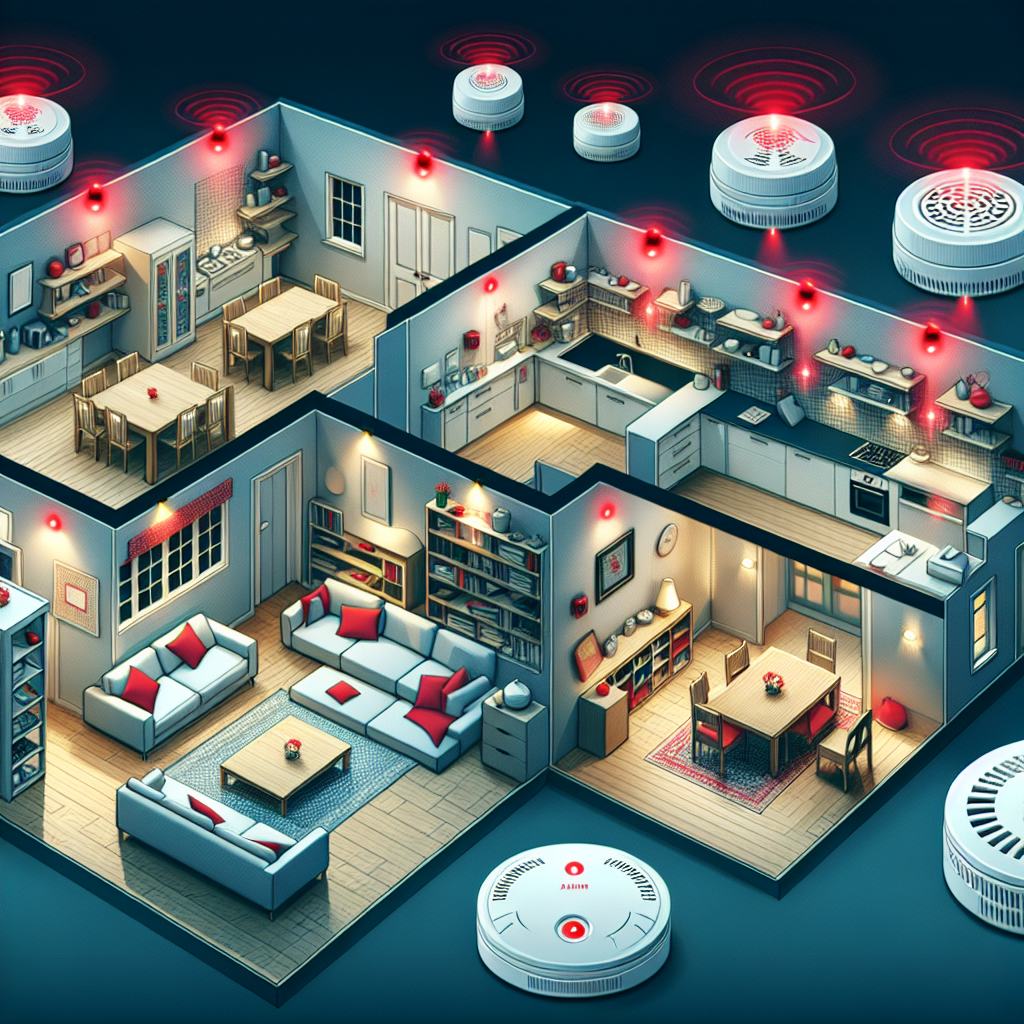Smoke and heat alarm systems are vital components in ensuring the safety of your home and loved ones. These systems are designed to detect any signs of smoke or sudden increases in temperature, alerting you to potential hazards and allowing you to take immediate action. By investing in a reliable smoke and heat alarm system, you are not only safeguarding your property from the devastating effects of fire but also providing yourself with peace of mind knowing that you have a first line of defense against emergencies. Join us as we delve into the essentials of how these systems work to protect your home.
Smoke and heat alarm systems safeguard your home by detecting smoke or unusually high temperatures, alerting residents of potential fires. These alarms provide early warning signals, giving people time to safely evacuate and potentially prevent property damage. By quickly detecting threats, these systems play a crucial role in keeping homes and their occupants safe from the dangers of fires.
Understanding the Importance of Smoke and Heat Alarm Systems
Smoke and heat alarm systems are crucial components of home safety measures designed to protect against the devastating effects of fire incidents. These systems are equipped with sensors that detect smoke particles or rising temperatures, triggering an alarm to alert occupants of potential danger. They serve as early warning devices, providing valuable time for evacuation and minimizing the risk of injuries or fatalities.
Definition and Purpose of Smoke and Heat Alarm Systems
- Smoke alarm systems are typically comprised of smoke detectors that monitor the air for traces of smoke, which could indicate a fire.
- Heat alarm systems, on the other hand, are designed to detect rapid increases in temperature, signaling a potential fire outbreak.
- The primary purpose of these alarm systems is to swiftly notify residents of a fire hazard, allowing for quick evacuation and timely intervention to prevent the spread of flames.
Statistics on the Effectiveness of Alarm Systems in Preventing Fire-Related Incidents
- According to the National Fire Protection Association (NFPA), homes with functioning smoke alarms have a significantly lower risk of fire-related fatalities.
- Studies have shown that smoke alarms can reduce the likelihood of dying in a home fire by nearly half.
- In the event of a fire, early detection provided by smoke and heat alarm systems can help emergency responders arrive on the scene promptly, increasing the chances of containing the fire and minimizing property damage.
Types of Smoke and Heat Alarm Systems
Smoke and heat alarm systems are essential components of home safety, providing early detection of fire hazards and minimizing the risk of injuries or fatalities. These alarm systems, whether ionization, photoelectric, or dual sensor, play a crucial role in safeguarding homes and can significantly reduce the likelihood of fire-related incidents. It is important to prioritize key features like battery backup, connectivity options, and smart features when selecting alarm systems to enhance the security of your household. Proper installation, maintenance, compliance with regulations, and integration with home security systems are vital steps to ensure the effectiveness of smoke and heat alarm systems in protecting your home and loved ones.
1. Ionization Smoke Alarms
Types of Smoke and Heat Alarm Systems
Ionization smoke alarms are a common type of smoke detection system that operates by using a small amount of radioactive material to ionize the air inside the detector. When smoke particles enter the ionization chamber, they disrupt the normal flow of ions, triggering the alarm to sound.
How ionization smoke alarms detect fires:
– Ionization smoke alarms detect fires by measuring the changes in the electrical currents caused by smoke particles entering the chamber.
– The radioactive material inside the alarm creates a constant flow of ions that get disrupted by smoke particles, causing the alarm to go off.
– These alarms are more responsive to fast-burning, flaming fires that produce smaller smoke particles.
Pros and cons of ionization smoke alarms:
– Pros:
– They are generally more affordable compared to other types of smoke alarms.
– Ionization smoke alarms are very sensitive to fast-flaming fires, providing quick detection in such situations.
– They are effective at detecting smoke particles that are not visible to the naked eye.
- Cons:
- Ionization smoke alarms are less effective at detecting slow, smoldering fires that produce larger smoke particles.
- They are more prone to false alarms from cooking smoke or steam, which can lead to desensitization by homeowners.
- The radioactive material used in ionization smoke alarms raises concerns about environmental impact and disposal.
2. Photoelectric Smoke Alarms
How photoelectric smoke alarms function
Photoelectric smoke alarms operate based on light detection principles. Inside the alarm, there is a light source that emits a beam of light into a sensing chamber. When smoke particles enter the chamber, they scatter the light, triggering the alarm to sound. This design makes photoelectric smoke alarms particularly effective at detecting smoldering fires, which produce larger smoke particles and can take longer to ignite into flames.
Advantages and disadvantages of photoelectric smoke alarms
Advantages:
– Effective at detecting smoldering fires: Photoelectric smoke alarms are known for their ability to quickly detect slow-burning, smoldering fires, providing early warnings to occupants.
– Less prone to false alarms: Compared to ionization smoke alarms, photoelectric alarms are less likely to be triggered by cooking fumes or steam, reducing the occurrence of false alarms.
– Broader coverage: These alarms are suitable for areas with higher humidity levels, such as kitchens and bathrooms, where steam or smoke from cooking may be present.
Disadvantages:
– Higher cost: Photoelectric smoke alarms tend to be slightly more expensive than ionization alarms, which may impact purchasing decisions, especially when outfitting an entire home.
– Limited effectiveness with fast-flaming fires: While excellent at detecting smoldering fires, photoelectric alarms may not be as responsive to rapidly spreading fires that produce fewer smoke particles initially.
– Regular maintenance required: Like all smoke alarms, photoelectric models need regular testing and maintenance to ensure they are functioning correctly and providing reliable protection.
3. Dual Sensor Smoke Alarms
Dual sensor smoke alarms utilize a combination of ionization and photoelectric technologies to detect different types of fires effectively.
-
Explanation of dual sensor technology: Ionization sensors are better at detecting fast-flaming fires, while photoelectric sensors excel at sensing slow, smoldering fires. By having both sensor types in one unit, dual sensor smoke alarms offer comprehensive fire detection capabilities. This dual technology approach significantly reduces false alarms and provides early detection of various fire types.
-
Benefits of dual sensor smoke alarms in detecting different types of fires: Dual sensor smoke alarms are highly effective in safeguarding homes against a wide range of fire hazards. They offer enhanced protection by promptly alerting residents to both fast-spreading fires and slow, smoldering fires, increasing the chances of early evacuation and minimizing property damage. By combining the strengths of ionization and photoelectric sensors, dual sensor smoke alarms provide a reliable and versatile solution for home fire safety.
Key Features to Look for in Smoke and Heat Alarm Systems

When considering smoke and heat alarm systems for your home, there are several key features that are essential to look out for to ensure the safety of your household.
Importance of Battery Backup in Alarm Systems
- Battery backup is a critical feature to consider in smoke and heat alarm systems as it ensures functionality during power outages.
- In the event of a fire or heat detection, having a reliable battery backup can be the difference between prompt alerting and a potentially disastrous situation.
- Modern alarm systems often come equipped with long-lasting lithium batteries that provide extended backup power to keep your home protected even when the electricity is out.
Connectivity Options for Remote Monitoring
- Another crucial feature to look for in smoke and heat alarm systems is connectivity options that allow for remote monitoring.
- With remote monitoring capabilities, homeowners can receive alerts and notifications on their smartphones or other devices, keeping them informed of any potential threats even when they are away from home.
- Some alarm systems offer Wi-Fi or cellular connectivity, enabling seamless communication between the alarm system and the homeowner, enhancing overall safety and peace of mind.
Smart Features such as Mobile Alerts and Integration with Home Security Systems
- Smoke and heat alarm systems with smart features have become increasingly popular due to their added convenience and accessibility.
- Mobile alerts are a valuable feature that instantly notifies homeowners of any detected smoke or heat, allowing for quick action to be taken.
- Integration with home security systems can further enhance the overall safety of the household by creating a comprehensive network of protection that can be easily managed and monitored remotely.
By prioritizing these key features in smoke and heat alarm systems, homeowners can significantly enhance the safety and security of their homes, providing peace of mind and protection for their families and property.

Installation and Maintenance Tips for Smoke and Heat Alarm Systems
Proper placement of alarms for optimal coverage:
- Ceiling placement: Install smoke alarms on the ceiling in the center of a room or hallway. For the best coverage, they should be at least 4 inches away from walls.
- Multiple alarms: Ensure there is at least one smoke alarm on every level of your home, including the basement and inside each bedroom.
- Interconnection: Consider interconnected smoke alarms so that when one alarm detects smoke or fire, all alarms in the house will sound.
Regular testing and maintenance routines to ensure functionality:
- Testing frequency: Test smoke and heat alarms at least once a month by pressing the test button. If the alarm doesn’t sound, replace the batteries immediately.
- Battery replacement: Change the batteries in your smoke alarms at least once a year, even if they are still working. Consider using long-life lithium batteries.
- Cleaning: Regularly clean your smoke alarms to prevent dust and debris from interfering with their sensors. Use a vacuum attachment or a soft brush to gently remove any buildup.
Common troubleshooting issues and how to address them:
- False alarms: False alarms can be triggered by cooking smoke or steam. To prevent this, install alarms away from kitchens and bathrooms.
- Chirping noise: A chirping noise usually indicates a low battery. Replace the battery promptly to ensure the alarm continues to function properly.

- Age of the alarm: Smoke alarms have a lifespan of around 10 years. If your alarm is older than this, consider replacing it with a newer model to ensure reliable detection.
Regulations and Standards for Smoke and Heat Alarm Systems
Overview of Regulatory Requirements for Smoke and Heat Alarms in Residential Buildings
In the realm of home safety, regulations regarding the installation and maintenance of smoke and heat alarm systems play a crucial role. These regulations are typically set forth by local building codes and national fire safety organizations. For instance, in the United States, the National Fire Protection Association (NFPA) establishes guidelines through its NFPA 72 National Fire Alarm and Signaling Code. These regulations often mandate the placement of alarms in specific areas of a residence, such as in bedrooms, hallways, and near kitchens. In addition, they may stipulate the type of alarms required, such as dual-sensor alarms that can detect both smoke and heat.
Compliance with Industry Standards to Ensure the Effectiveness of Alarm Systems
Beyond regulatory requirements, adherence to industry standards is essential to guarantee the reliability and functionality of smoke and heat alarm systems. Industry standards outline best practices for the design, installation, and testing of these systems to ensure they operate effectively in the event of a fire emergency. For example, the Underwriters Laboratories (UL) certification is a widely recognized standard that indicates an alarm system meets specific safety and quality criteria. By complying with these standards, homeowners can have confidence that their smoke and heat alarms are capable of providing early detection and warning in the event of a fire, potentially saving lives and property.
Integrating Smoke and Heat Alarm Systems into Your Home Security Setup
In today’s interconnected world, the importance of integrating smoke and heat alarm systems into your home security setup cannot be overstated. By combining these critical safety devices with your existing security infrastructure, you create a robust defense mechanism that can help safeguard your home and loved ones from potential threats. Here are some key points to consider when integrating smoke and heat alarm systems into your home security setup:
Benefits of integrating alarm systems with a comprehensive home security system
-
Enhanced Protection: Integrating smoke and heat alarm systems with your home security setup provides an additional layer of protection against fire-related emergencies. These systems can detect early signs of smoke or heat, allowing for quicker response times in case of a fire.
-
Improved Monitoring: By connecting your alarm systems to your home security network, you can remotely monitor the status of these devices. This real-time monitoring capability enables you to receive instant alerts on your smartphone or computer in case of any detected smoke or heat, even when you’re away from home.
-
Seamless Communication: Integration allows for seamless communication between your smoke and heat alarm systems and other security devices in your home. In the event of an alarm trigger, these interconnected systems can work together to activate other safety measures, such as turning on lights, unlocking doors for easy exit, or alerting emergency services.
Tips for selecting compatible devices and ensuring seamless integration for maximum protection
-
Research and Compatibility: When choosing smoke and heat alarm systems for integration, ensure compatibility with your existing home security system. Conduct thorough research to select devices that can seamlessly integrate with your current setup, minimizing potential compatibility issues.
-
Professional Installation: To guarantee proper integration and functionality, consider hiring a professional to install and configure your smoke and heat alarm systems. Professional installers have the expertise to ensure that all components work together effectively, maximizing the overall security of your home.
-
Regular Testing and Maintenance: Once integrated, regularly test and maintain your smoke and heat alarm systems to ensure they function correctly. Conduct routine checks, replace batteries as needed, and address any issues promptly to maintain the integrity of your home security setup.
By integrating smoke and heat alarm systems into your home security setup and following these tips, you can enhance the safety of your home and create a comprehensive defense strategy against fire-related emergencies.
FAQs: Exploring the Essentials: How Do Smoke and Heat Alarm Systems Safeguard Your Home?
How do smoke alarms work?
Smoke alarms have a sensor that detects smoke particles in the air. When smoke is detected, the alarm sounds a loud alert to notify inhabitants of a potential fire. This early warning allows occupants to evacuate the building quickly and reduces the risk of injury or property damage.
How do heat alarms work?
Heat alarms are designed to detect rapid increases in temperature rather than smoke. When the temperature in a room rises above a certain threshold, the heat alarm triggers an alert to warn residents of a possible fire. This feature is particularly useful in areas with high levels of dust, steam, or smoke, where smoke alarms may be prone to false alarms.
Why is it important to have both smoke and heat alarms in a home?
Having both smoke and heat alarms in a home provides comprehensive protection against fires. Smoke alarms are effective at detecting fires in their early stages, while heat alarms are better equipped to detect fires that produce little smoke, such as electrical fires. By having both types of alarms installed, residents can receive timely alerts in various fire scenarios, increasing their chances of safely escaping a burning building.
How often should smoke and heat alarms be tested?
It is recommended to test smoke and heat alarms at least once a month to ensure they are functioning properly. In addition, both types of alarms should be replaced every 8-10 years, as their sensors may deteriorate over time and become less effective at detecting fires. Regular maintenance and testing of these alarms are essential to ensure the safety of occupants in the event of a fire.